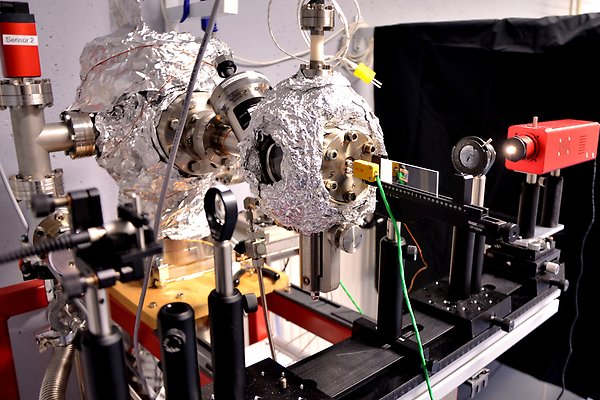Optical measurements in a controlled environment
The optical set-up for gas loading experiments (OSFOLD) is designed for measurements of optical transmission while exposing the sample to different gases or temperatures. A light source irradiating white light with 360-2600 nm wavelength, an additional high-intensity LED, and a CCD spectrometer are the main optical elements of this set-up allowing even for pump-probe experiments. The measurement chamber can be filled with different gases and heated completely up till 150°C with the help of heating band ensuring measurement conditions under thermal equilibrium even at higher temperatures.
The set-up has been used in a recent study on the effect of ion irradiation on the optical properties of the photochromic material YHO. Another field of study is the absorption of hydrogen in vanadium thin films with relevance for hydrogen-storage applications.

A new setup for optical measurements under controlled environment
Part of Review of Scientific Instruments, 2023
- DOI for A new setup for optical measurements under controlled environment
- Download full text (pdf) of A new setup for optical measurements under controlled environment
Part of The Journal of Physical Chemistry C, p. 24676-24682, 2023
- DOI for Modification of the Photochromic Properties of Oxygen-Containing Yttrium Hydride by Irradiation with keV and MeV Ions
- Download full text (pdf) of Modification of the Photochromic Properties of Oxygen-Containing Yttrium Hydride by Irradiation with keV and MeV Ions
Features
- Set-up consisting of two vacuum chambers separated by a gate valve.
- First chamber: ultra-high vacuum chamber equipped with a residual gas analyser with a nominal sensitivity of 10-11 mbar for mass 28.
- Second chamber: dedicated to optical measurements and featuring two glass viewports to this aim.
- Gas feeding line allowing for inlet of for example H2, Ar eller O2.
- By heating the entire second chamber via heating bands, measurements can be performed under thermal equilibrium.
- Stabilized tungsten-halogen source providing light in a wavelength range from 360 to 2600 nm.
- High-intensity LEDs ranging from UV (365 nm) to red light (617 nm) for pump-probe experiments mounted perpendicular to the optical line.
- Dichroic mirror for creating two coaxial beams from the reflected pump light and the transmitted probing light.
- CCD spectrometer working in a range of 200-1000 nm.

